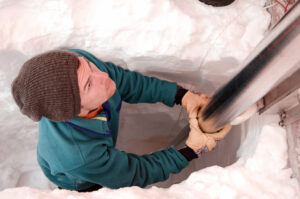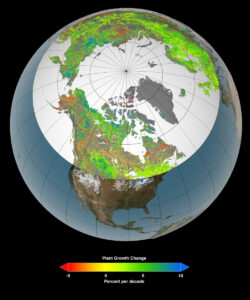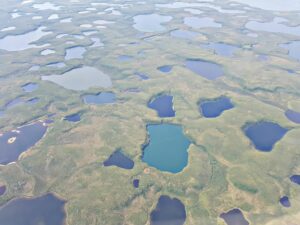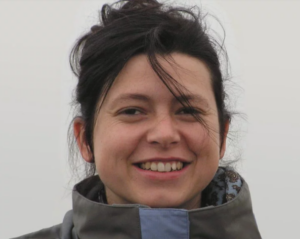Weather unstable? Jet Stream winds delivering extreme heat, cold & storms to the Northern Hemisphere are changing. American expert Dr. Matt Osman breaks new research. From Austria, Dr. Annett Bartsch brings us Arctic permafrost risk. Human settlement in the far north is unsustainable without fossil fuels.
Heating at the Poles will determine the fate of this life on Earth. The first and largest human impact on the planet is threatening human settlements, roads, and pipelines in the far north, as the ground thaws. Forests fall over. Buildings and roads crack open. Oil and gas lines break, even as our energy crisis develops.
Listen to or download this Radio Ecoshock show in CD Quality (57 MB) or Lo-Fi (16 MB)
When the last great glaciers finally pulled back from North America and Europe, Earth warmed 6 degrees C – over 10 degrees Fahrenheit – to reach the climate you feel today. That took about 20,000 years. Now in the worst case scenario, humans may heat the planet another 6 degrees C. in less than 200 years. Not much of the life you recognize could survive that.
Even wilder, Dr. Osman’s team found increasing greenhouse gases are not enough to explain that kind of temperature rise in less than 20,000 years. When the great white ice sheets stopped reflecting sunlight back to space, that added as much heat, or more, than greenhouse gases. In the last couple of decades, Arctic sea ice has shrunk and Greenland is melting at a furious pace. Snow covers the Arctic lands less and less each year. That loss of reflection, called “albedo” change, adds to warming coming from human greenhouse gas emissions. Dr. James Hansen warned of all this, a major shift in Earth’s energy imbalance.
That is why we spend so much time on Radio Ecoshock investigating changes in the Arctic, a place hardly mentioned in mainstream news. Plus, as we heard from scientist Nico Wunderling in my November 3rd show “Cascading Tipping Points” – new studies show ice melt on Greenland is the first planetary tipping point. When megatons of fresh water pour off Greenland into the Atlantic, Earth systems from temperate weather to Amazon die-back, to the South Pole can be triggered. Concurrent with thawing permafrost land, Greenland is melting now.
So I ask for your curiosity and patience as we dig into scientific reports – what we now know about the great Arctic shift. Here we go.
========================================================
THINKING OF GIVING? This radio show tries to broadcast the truth about our climate crisis and our perilous relationships with nature. The future is at state. Can you help me keep going? This low-budget program just needs a little more love to reach people all over the world, for free. Please donate what you can here. Alex.
========================================================
MATTHEW OSMAN: THE TRUTH ABOUT THE JET STREAM
High above our heads runs a fast-moving river of air. We call it the Jet Stream. The river flows, meanders, rushes by, sometimes splits. It is also known as the Polar Vortex, and for those in the Northern Hemisphere, the North Atlantic jet stream. Fluid in the atmosphere, paths of the Jet Stream move north or south in mere days, driving large changes in weather down below.
When the Jet Stream tends north for a while, Spain can dry up and burn, while Scandinavia gets more rain and snow. Famines in history are attributed to changes in the Jet Stream. But will this great wind track change along with the climate? Food systems and economies may depend on the answer.
We cannot know if something changes unless we know what it was before. But winds like the Jet Stream leave no tracks. Or do they? A team of scientists led by American scientist Matthew Osman found records reflecting the Jet Stream, year by year, in drill cores taken from Greenland ice. Matthew B. Osman is a Postdoctoral Research Associate at the Climate Systems Center at the University of Arizona. Measuring characteristics of ice, Osman and his colleagues create a long time map of winds, climate, drought and rain.

Dr. Matt Osman, working the ice. Woods Hole photo.
Listen to or download this 27 minute interview with Matthew Osman in CD Quality or Lo-Fi
Osman is lead author for a brand new paper just published In Nature. His team mapped Earth’s climate for the last 24,000 years – since the peak of the last Ice Age. The title is: “Globally resolved surface temperatures since the Last Glacial Maximum” (2021).
A NEW STORY OF THE CARBON PAST
There were surprises. There are papers and articles saying the world has warmed since the development of agriculture some 10,000 years ago, as though humans were already warming the world. But this new temperature mapping suggests a revision: most of the warming happened BEFORE humans developed agriculture. That last warming since the last Glacial Maximum may not have been stimulated by humans, instead being part of a natural cycle.
WARMING BEYOND GREENHOUSE GASES: ALBEDO CHANGE
I was shocked to learn from this paper the world has warmed a little over 6 degrees C since the time of the big continent-covering glaciers. That is a lot! The scientists find changing greenhouse gases are not enough to explain that kind of temperature rise in less than 20,000 years. The other big driver warming the planet was the massive change in reflecting sunlight back into space, when sea ice and glaciers melt away to darker sea or land. So we have to remember albedo change is a MAJOR factor in global warming, now as the sea ice is so low, and snow seasons shorter.
The paper says:
“Modeling experiments indicate that the magnitude of ice sheet albedo forcing is comparable to (if not greater than) GHG forcing across the deglacial transition.”
WETTING THE ARCTIC
In another study, published in Nature Geoscience this year, Osman and colleagues describes long periods of increasing snow on Greenland – because of warming. That paper is “Abrupt Common Era hydroclimate shifts drive west Greenland ice cap change“.
It is strange warming could drive more snow there. In the next couple of weeks, I will speak to a Canadian scientist who also says there will be more rain than snow in the Arctic. In general, as the world heats up, big projections show bands of drying north and south of the equator, and a much wetter far north.

ANOTHER RE-THINK: HAS CLIMATE CHANGE MOVED THE JET STREAM?
We also discuss yet another Osman-led paper “North Atlantic jet stream projections in the context of the past 1,250 years”. That was published in September 2021 in the Proceedings of the National Academy of Sciences (PNAS).
The “Significance” statement for this paper is worth your read:
“The North Atlantic jet stream impacts North American and European societies and is expected to be influenced by ongoing 21st-century warming. To better contextualize recently observed and model-projected jet stream changes, long-term records are required. We use insights from a state-of-the-art water isotope–enabled climate model and a compilation of ice-core records from Greenland to reconstruct mean annual North Atlantic jet stream changes back to the 8th century CE.
Our reconstruction suggests that observed jet stream variations are consistent with natural variations, despite dramatic warming across recent decades. Under unabated future warming, however, a progressive migration of the jet stream northward is projected to render it distinct from natural variability by 2060 CE.”
We also find out the Jet stream in north extends right to the ground, being called “the North Atlantic Storm Track” closer to the surface. That is why there are ice cores in Greenland that actually record the Jet Stream for thousands of years.
GREENLAND MAY BE THE KEY CLIMATE TRIGGER
As we learned from several guests on this show, it looks like Greenland Ice Sheet melt could be the first trigger toward a cascade of climate shifts in other parts of the world, as far as the South Pole. That is partly because the great melt of Greenland starts around our current extra 1 degrees rise over preindustrial. That warning is reinforced by this research by Osman et al where the last interglacial, about 120,000 yrs ago, had similar ice loss though about 1 degree cooler than today. This big change has a low stimulation point. Now triggered, Greenland will continue to melt for centuries no matter what Greenhouse Gas levels are.
========================================================
ANNETT BARTSCH
PERMAFROST THAW & NEW ARCTIC LANDSCAPE

“Thermokarst” post-permafrost landscape, Tuktoyaktuk Canada.
One of the first and largest planetary-scale impacts of warming is in the Arctic. It is not disappearing sea ice. Cities, roads, pipelines – everything humans built in the Polar world is on land long frozen. Now that is thawing as the Arctic warms faster than anywhere else on Earth. How much damage and how much risk is unknown – until a new paper.
Dr. Annett Bartsch is the lead author of the study “Expanding infrastructure and growing anthropogenic impacts along Arctic coasts”. Her team found over half the buildings, roads and pipelines within 60 miles or 100 kilometers of the Arctic coast will be on unstable ground within the next 30 years. Dr. Bartsch is a member of the Austrian Polar Research Institute, and directs her own company called b.geos.

Dr. Annett Bartsch, Austria.
There are two exciting advances reported in this paper:
1. a new and first accurate map of human development in the Arctic
2. lay that info over the latest permafrost mapping, leading to:
..a fact-based appraisal of how much human development is at risk as the ground below it thaws and then sags or moves. More than half of everything from homes to roads to oil and gas installations may need to be repaired, rebuilt or abandoned as permafrost thaws in a warming world. Half. Of everything.
ROAD NETWORKS AT RISK, FROM CHINA TO CANADA
The Chinese are battling with the same problem with a major road leading to the high Tibetan Plateau. Basically, they have to rebuild the road every year. Canadians are facing the same in the far north, as reported in this BBC article:
“Guy Doré has seen the local effects for himself. The long cracks in the asphalt of a road can spread so wide that you can get your foot down into the gap. Doré, at Laval University in Canada, has studied the effects of thawing permafrost on built infrastructure for years. ‘The problems are huge,’ he says, adding that roughly half of the 3-4,000km (1800-2500 miles) of road constructed in permafrost areas in Canada are at risk of becoming unstable due to thawing: ‘We’re talking millions of dollars in additional maintenance costs in areas where you don’t have much resource to do it.’”
The first part “make a map” sounds easy: just go to Google Earth and count up the buildings or something. Getting a real map is far harder. A lot of this work depends upon the Copernicus “Eye in the Sky” satellite project established by the European Union. The European Space Agency contracted Bartsch and b.geos to help digest mountains of satellite data into patterns of human presence.
For example, they found settlements not on any maps. The team had to figure out differences in reflection by a dry gravel river bed versus a gravel road. A lot of nuances had to be combed through, with machine learning help. They also measured a 15% increase in human development since 2000! The oil and gas industry accounted for 31% of that increase since 2000.
About twenty four percent of all land in the Northern Hemisphere has been permanently frozen. Now it is thawing rapidly as the planet warms. This is a planetary event caused by climate change, and seldom discussed in our daily media,
Listen to or download this 30 minute interview with Annett Bartsch in CD Quality or Lo-Fi
When the Soviet government dumped chemicals and atomic waste in the Arctic, they knew if would stay entombed in ice. The first Arctic cities were built on permanently frozen ground. Vast pipelines supplying Europe with natural gas for heat and industry run across Siberia’s frozen landscape. No one could believe the legendary land of cold could get warm enough to thaw. Now permafrost has lost it’s permanency, and half of everything humans built in the Arctic will need endless repairs or be abandoned.
Over three million people now live in the Arctic. About a third of them are indigenous or local ethnic groups. The rest are settlers who came for mining, oil and gas, and lately for shipping. Almost all of them depend on fossil fuels to survive.
DON’T COUNT ON DELIVERY OF THAT ARCTIC GAS OR OIL…
The study Annett Bartsch lead found 38% of all new human development built on at-risk permafrost is for the oil and gas industry. Human addiction to fossil fuels is the biggest single driver of Arctic incursion. The source and cause of climate wrecking the whole world is expanding North toward the Pole.
The study finds:
“More than half (55%) “of the identified human impacted area will be shifting to above 0 [deg] C ground temperature at two meter depth by 2050 if current permafrost warming trends continue at the pace of the last two decades...”
SEE ALSO: “Degrading permafrost puts Arctic infrastructure at risk by mid-century”, lead author Jan Hjort, published December 11, 2018.
OTHER RADIO ECOSHOCK PERMAFROST GUESTS
Merritt Turetsky
Susan Natali
Disaster in the Making: Cascading Tipping Points & Permafrost
ALEX SAYS:
HUMAN EXPANSION INTO THE ARCTIC IS UNSUSTAINABLE
In the Arctic, solar power can only work a few months a year. The Arctic goes sunless and dark for months every winter. Wind turbines can work in the Arctic just as they currently keep turning at Antarctic bases. Geothermal power and heat may be possible.
But these days, homes are heated with fossil fuels. Cars, trucks, and snowmobiles burn gas or diesel. Every industrial operation there needs them. Roads are paved with fossil fuels. Food, computers, everything is delivered by gas or oil. The harsh fact is: except for a few hunters and trappers, human development in the Arctic is more dependent on fossil fuels than anywhere else on Earth.
Now we find burning those same fossil fuels means half of everything in the far north will need even more fossil fuels to repair or rebuild, in some cases every year. And that unstable infrastructure is increasing as humans see the Arctic as a new frontier to plunder. We have another feedback loop: human development of the Arctic adds to global warming that undercuts the very foundations of human development.
These days it is fashionable to talk about humans and agriculture moving northward to escape burning heat further south. It is a stupid dream, a lie we tell ourselves for comfort. When you can find Arctic soil, it is thin and acidic. The growing season is short to non-existent due to frost any month of the year. Agriculture is not going to happen in the Arctic on any scale to support cities there. Pretending the Arctic is some kind of life-boat for overheated Earth is madness. That is just another escape dream, like colonizing Mars. Give it up.
With the extreme climate emergency, we need to reverse that dream. We are at the choke point when there is no “room” left in the atmosphere for more emissions. In this severe emergency, masses of humans need to withdraw from the Arctic until a civilization without fossil dependency emerges. We also need to wait until the land there stabilizes and nature adapts how she can.
At the other end of the world, Greenpeace demanded Antarctica be declared a world park. In 1991, members of the Antarctic Treaty agreed a minimum 50 year prohibition of mineral mining there. As fossil dependent development in the Arctic threatens the livable climate of the whole world, it is time to prohibit further growth in the Arctic, and begin a plan of withdrawal, starting with the oil and gas industry. All new oil and gas exploration there must be banned. Existing wells and pipelines need to be dismantled and cleaned up, for the sake of our kids and grandchildren.
Yes, it is possible the fossil gangsters who dominate economies of Northern countries would start a world war before they give up their dreams to drill and mine out all Arctic land and sea. Yes, homes and industry in Europe, Canada, and the U.S. need to find safe energy fast, as the Arctic taps turn off. The same governments have to stop building their fragile territorial claims by subsidizing settlement and development in the Arctic. Major banks need to end loans for Arctic projects. Nobody needs to invest in wrecking the planet, especially the Arctic trigger for cascading tipping points.
Let the great withdrawal from the Arctic begin, until the new fossil-free and sustainable civilization comes. That is what reality demands for our common survival. Get out of the Arctic and leave it alone. Pass it on.
I’m Alex Smith. Thank you for listening and caring about our world.
Pingback: The week in nuclear news | Nuclear Australia